world.wikisort.org - Italy
Lucca (/ˈluːkə/ LOO-kə, Italian: [ˈlukka] (![]() listen)) is a city and comune in Tuscany, Central Italy, on the Serchio River, in a fertile plain near the Ligurian Sea. The city has a population of about 89,000,[3] while its province has a population of 383,957.[4]
listen)) is a city and comune in Tuscany, Central Italy, on the Serchio River, in a fertile plain near the Ligurian Sea. The city has a population of about 89,000,[3] while its province has a population of 383,957.[4]
Lucca | |
|---|---|
Comune | |
| Comune di Lucca | |
 View of Lucca (2022) | |
 Flag  Coat of arms | |
Location of Lucca  | |
 Lucca Location of Lucca in Italy  Lucca Lucca (Tuscany) | |
| Coordinates: 43°50′30″N 10°30′10″E | |
| Country | Italy |
| Region | Tuscany |
| Province | Lucca (LU) |
| Frazioni | see list |
| Government | |
| • Mayor | Mario Pardini ([Independent]) |
| Area | |
| • Total | 185.5 km2 (71.6 sq mi) |
| Elevation | 19 m (62 ft) |
| Population (30 September 2017)[2] | |
| • Total | 89,346 |
| • Density | 480/km2 (1,200/sq mi) |
| Demonym | Lucchesi |
| Time zone | UTC+1 (CET) |
| • Summer (DST) | UTC+2 (CEST) |
| Postal code | 55100 |
| Dialing code | 0583 |
| ISTAT code | 046017 |
| Patron saint | St. Paulinus |
| Saint day | July 12 |
| Website | Official website |
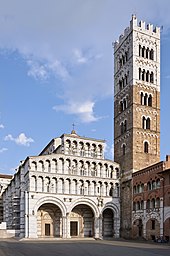
Lucca is known as one of the Italian's "Città d'arte" (Arts town), thanks to its intact Renaissance-era city walls[5] and its very well preserved historic center, where, among other buildings and monuments, are located the Piazza dell'Anfiteatro, which has its origins in the second half of the 1st century A.D. and the Guinigi Tower, a 45-metre-tall (150 ft) tower that dates from the 1300s.[7][8]
The city is also the birthplace of numerous world-class composers, including Giacomo Puccini, Alfredo Catalani, and Luigi Boccherini.[9]
Toponymy
By the Romans, Lucca was known as Luca. From more recent and concrete toponymic studies, the name Lucca has references that lead to "sacred wood" (Latin: lucus), "to cut" (Latin: lucare) and "luminous space" (leuk, a term used by the first European populations). The origin apparently refers to a wooded area deforested to make room for light or to a clearing located on a river island of Serchio debris, in the middle of wooded areas.[10][11]
History
Antiquity
The territory of present-day Lucca was certainly settled by the Etruscans, having also traces of an probable earlier Ligurian presence (called Luk meaning "marsh", which has already been speculated as a possible origin for the city's name), dating from 3rd century BC. However, it was only with the arrival of the Romans, that the area took on the appearance of a real town, obtaining the status of a Roman colony in 180 BC, and transformed into a town hall in 89 BC.[12][13]
The rectangular grid of its historical centre preserves the Roman street plan, and the Piazza San Michele occupies the site of the ancient forum. The outline of the Roman amphitheatre is still seen in the Piazza dell'Anfiteatro, and the outline of a Roman theater is visible in Piazza Sant'Augostino. Fragments of the Roman-era walls are incorporated into the church of Santa Maria della Rosa.
At the Lucca Conference, in 56 BC, Julius Caesar, Pompey, and Crassus reaffirmed their political alliance known as the First Triumvirate.[13][14]
Middle Ages

Frediano, an Irish monk, was bishop of Lucca in the early sixth century.[15] At one point, Lucca was plundered by Odoacer, the first Germanic King of Italy. Lucca was an important city and fortress even in the sixth century, when Narses besieged it for several months in 553. From 576 to 797, under the Lombards, it was the capital of a duchy, known as Ducato di Tuscia, which included a large part of today's Tuscany and the province of Viterbo, during this time the city also minted its own coins.[16] The Holy Face of Lucca (or Volto Santo), a major relic supposedly carved by Nicodemus, arrived in 742.
Among the population that inhabited Lucca in the medieval era, there was also a significant presence of Jews. The first mention of their presence in the city is from a document from the year 859. The jewish community was led by the Kalonymos family (which later became a major component of proto-Ashkenazic Jewry).[17]
Thanks above all to the Holy Face and to the relics of important saints, such as San Regolo and Saint Fridianus, the city was one of the main destinations of the Via Francigena, the major pilgrimage route to Rome from the north.[18]
The Lucca cloth was a silk fabric that was woven with gold or silver threads. It was a popular type of textile in Lucca throughout the mediaeval period.[19][20]
Lucca became prosperous through the silk trade that began in the eleventh century, and came to rival the silks of Byzantium. During the tenth–eleventh centuries Lucca was the capital of the feudal margraviate of Tuscany, more or less independent but owing nominal allegiance to the Holy Roman Emperor.
In 1057 Anselm of Baggio (later Pope Alexander II) was appointed bishop of Lucca, a position he held also during the papacy. As bishop of Lucca he managed to rebuild the patrimony of the Church of Lucca, recovering alienated assets, obtaining numerous donations thanks to his prestige, and had the Cathedral of the city rebuilt. From 1073 to 1086, the bishop of Lucca was his nephew Anselm II, a prominent figure in the Investiture Controversy.[21][22]
During the High Middle Ages, one of the most illustrious dynasties of Lucca was the noble Allucingoli family, who managed to forge strong ties with the Church. Among the family members were Ubaldo Allucingoli, who was elected to the Papacy as Pope Lucius III in 1181, and the Cardinals Gerardo Allucingoli and Uberto Allucingoli.[23][24]
Republican period (12th to 19th century)
After the death of Matilda of Tuscany, the city began to constitute itself an independent commune with a charter in 1160. For almost 500 years, Lucca remained an independent republic. There were many minor provinces in the region between southern Liguria and northern Tuscany dominated by the Malaspina; Tuscany in this time was a part of feudal Europe. Dante’s Divine Comedy includes many references to the great feudal families who had huge jurisdictions with administrative and judicial rights. Dante spent some of his exile in Lucca.
In 1273 and again in 1277, Lucca was ruled by a Guelph capitano del popolo (captain of the people) named Luchetto Gattilusio. In 1314, internal discord allowed Uguccione della Faggiuola of Pisa to make himself lord of Lucca. The Lucchesi expelled him two years later, and handed over the city to another condottiero, Castruccio Castracani, under whose rule it became a leading state in central Italy. Lucca rivalled Florence until Castracani's death in 1328. On 22 and 23 September 1325, in the battle of Altopascio, Castracani defeated Florence's Guelphs. For this he was nominated by Louis IV the Bavarian to become duke of Lucca. Castracani's tomb is in the church of San Francesco. His biography is Machiavelli's third famous book on political rule.
Occupied by the troops of Louis of Bavaria, the city was sold to a rich Genoese, Gherardino Spinola, then seized by John, king of Bohemia. Pawned to the Rossi of Parma, by them it was ceded to Mastino II della Scala of Verona, sold to the Florentines, surrendered to the Pisans, and then nominally liberated by the emperor Charles IV and governed by his vicar.
In 1408, Lucca hosted a convocation organized by Pope Gregory XII with his cardinals intended to end the schism in the papacy.[25]
Lucca managed, at first as a democracy, and after 1628 as an oligarchy, to maintain its independence alongside of Venice and Genoa, and painted the word Libertas on its banner until the French Revolution in 1789.[26]
Early modern period

Lucca had been the second largest Italian city state (after Venice) with a republican constitution ("comune") to remain independent over the centuries.
Between 1799 and 1800 it was contended by the French and Austrian armies. Finally the French prevailed and granted a democratic constitution in the 1801. However, already in 1805 the Republic of Lucca was converted into a monarchy by Napoleon, who installed his sister Elisa Bonaparte Baciocchi as "Princess of Lucca".
From 1815 to 1847 it was a Bourbon-Parma duchy. The only reigning dukes of Lucca were Maria Luisa of Spain, who was succeeded by her son Charles II, Duke of Parma in 1824. Meanwhile, the Duchy of Parma had been assigned for life to Marie Louise, Duchess of Parma, the second wife of Napoleon. In accordance with the Treaty of Vienna (1815), upon the death of Marie Louise, Duchess of Parma in 1847, Parma reverted to Charles II, Duke of Parma, while Lucca lost independence and was annexed to the Grand Duchy of Tuscany. As part of Tuscany, it became part of the Kingdom of Sardinia in 1860 and finally part of the Italian State in 1861.
World War II internment camp
In 1942, during World War II, a prisoner-of-war camp was established at the village of Colle di Compito, in the municipality of Capannori, about 11 kilometres (6.8 mi) from Lucca. Its official number was P.G. (prigionieri di guerra) 60,[27] and it was usually referred to as PG 60 Lucca.[28] Although it never had permanent structures and accommodation consisted of tents in an area prone to flooding, it housed more than 3,000 British and Commonwealth prisoners of war during the period of its existence. It was handed over to the Germans on 10 September 1943, not long after the signing of the Italian armistice. During the Italian Social Republic, as a puppet state of the Germans, political prisoners, foreigners, common law prisoners and Jews were interned there, and it functioned as a concentration camp. In June 1944 the prisoners were moved to Bagni di Lucca.[27]
Government
Culture
Lucca is the birthplace of composers Giacomo Puccini (La Bohème and Madama Butterfly), Nicolao Dorati, Francesco Geminiani, Gioseffo Guami, Luigi Boccherini, and Alfredo Catalani. It is also the birthplace of artist Benedetto Brandimarte. Since 2004, Lucca is home to IMT Lucca, a public research institution and a selective graduate school and part of the Superior Graduate Schools in Italy (Grandes écoles).[29]

Events
Lucca hosts the annual Lucca Summer Festival. The 2006 edition featured live performances by Eric Clapton, Placebo, Massive Attack, Roger Waters, Tracy Chapman, and Santana at the Piazza Napoleone.
Lucca hosts the annual Lucca Comics and Games festival, Europe's largest festival for comics, movies, games and related subjects.
Other events include:
- Lucca Film Festival[30]
- Lucca Digital Photography Fest[31]
- Procession of Santa Croce, on 13 September. Costume procession through the town's roads.
- Lucca Jazz Donna[32]
Moreover, Lucca hosts Lucca Biennale Cartasia,[33] an international biennial contemporary art exhibition focusing solely on Paper Art.
Film and television
Mauro Bolognini's 1958 film Giovani mariti, with Sylva Koscina, is set and was filmed in Lucca.[citation needed]
Top Gear filmed the third episode of the 17th season here.
Architecture
Lucca is also known for its marble deposits. After a fire in the early 1900s, the West Wing of the Legislative Assembly of Ontario was rebuilt with marble sourced in Lucca. The floor mosaic in the West Wing was hand-laid and is constructed entirely of Italian, Lucca marble.
Main sights
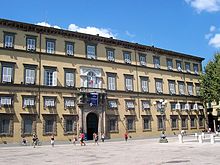
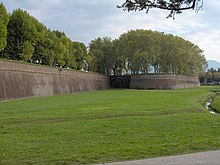


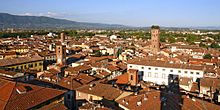
Walls, streets, and squares
The walls encircling the old town remain intact, even as the city expanded and modernized, unusual for cities in the region. Initially built as a defensive rampart, once the walls lost their military importance they became a pedestrian promenade, the Passeggiata delle Mura Urbane, a street atop the walls linking the bastions. It passes through the Bastions of Santa Croce, San Frediano, San Martino, San Pietro/Battisti, San Salvatore, La Libertà/Cairoli, San Regolo, San Colombano, Santa Maria, San Paolino/Catalani, and San Donato; and over the gates (Porte): San Donato, Santa Maria, San Jacopo, Elisa, San Pietro, and Sant'Anna. Each of the four principal sides of the structure is lined with a different tree species than the others.
The walled city is encircled by Piazzale Boccherini, Viale Lazzaro Papi, Viale Carlo Del Prete, Piazzale Martiri della Libertà, Via Batoni, Viale Agostino Marti, Viale G. Marconi (vide Guglielmo Marconi), Piazza Don A. Mei, Viale Pacini, Viale Giusti, Piazza Curtatone, Piazzale Ricasoli, Viale Ricasoli, Piazza Risorgimento (vide Risorgimento), and Viale Giosuè Carducci.
The town includes a number of public squares, most notably the Piazza dell'Anfiteatro, site of ancient Roman amphitheater; but also Piazzale Verdi; Piazza Napoleone; and Piazza San Michele.



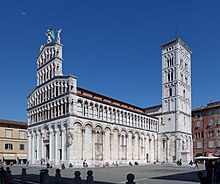

Palaces, villas, houses, offices, and museums
- Ducal Palace: built on the site of Castruccio Castracani's fortress. Construction began by Ammannati in 1577–1582, and continued by Juvarra in the eighteenth century
- Pfanner Palace
- Villa Garzoni, noted for its water gardens
- Casa di Puccini: House of the opera composer, at the nearby Torre del Lago, where the composer summered. A Puccini opera festival takes place every July–August
- Torre delle Ore: ("The Clock Tower")
- Guinigi Tower and House: Panoramic view from tower-top balcony with oak trees
- National Museum of Villa Guinigi
- National Museum of Palazzo Mansi
- Orto Botanico Comunale di Lucca: botanical garden dating from 1820
- Academy of Sciences (1584)
- Teatro del Giglio: nineteenth-century opera house
Churches
There are many medieval, a few as old as the eighth century, basilica-form churches with richly arcaded façades and campaniles
- Duomo di San Martino: St Martin's Cathedral
- San Michele in Foro: Romanesque church
- San Giusto: Romanesque church
- Basilica di San Frediano
- SanSan Romano, Luccat'Alessandro[34] an example of medieval classicism
- Santa Giulia: Lombard church rebuilt in thirteenth century
- San Michele: church at Antraccoli, founded in 777, it was enlarged and rebuilt in the twelfth century with the introduction of a sixteenth-century portico
- San Giorgio church in the locality of Brancoli, built in the late twelfth century has a bell tower in Lombard-Romanesque style, the interior houses a massive ambo (1194) with four columns mounted on lion sculptures, a highly decorated Romanesque octagonal baptismal fount, and the altar is supported by six small columns with human figures
- San Lorenzo di Moriano, a 12th century Romanesque style parish church
- San Romano, erected by the Dominican order in the second half of the 13th century, is today a deconsecrated Roman Catholic Church located on Piazza San Romano in the center of Lucca
Museums
- Museo della Cattedrale
- Orto Botanico Comunale di Lucca
Education
Since 2005, Lucca hosts IMT School for Advanced Studies Lucca, a selective graduate and doctoral school which is part of the Italian superior graduate school system. Its main educational facilities are located at the San Francesco Convent Complex and Campus, and the former Renaissance-style Roman Catholic church of San Ponziano now hosts the university library.
Sports
Association Football arrived in Lucca in 1905 and has its roots in Brazil, thanks to a number of fans that helped found the club who had learned the game in Brazil. The Lucchese 1905, or simply Lucchese, play in Serie C, the third tier of Italian football, having last been in top tier Serie A in 1952. The club plays their home games at Stadio Porta Elisa, just outside the northeast wall of the city.[35][36]
Transportation
Buses
Consorzio Lucchese Autotrasporti Pubblici, also known as CLAP, was established in 1969, as the main company in the Province of Lucca to manage the local public transport. In 2005, following the decision of the Region to assign the local public transport to a single operator for each of the 14 lots constituted, CLAP merged with the companies Lazzi and C.LU.B. Scpa to form the consortium VaiBus which was absorbed by the newly formed company CTT Nord in 2012. VaiBus was part of ONE Scarl the consortium holder of the two-year (2018-2019) contract for the management of the TPL throughout the Region.[37]
Since 1 November 2021 the public local transport is managed by Autolinee Toscane.[38]
Notable people
- St. Anselm of Lucca, (1036–1086), bishop of Lucca
- Giovanni Arnolfini, merchant and arts patron
- Pompeo Batoni, painter
- Giovanni Antonio Bianchi (1686–1768), Italian Friar Minor, theologian, and minor Tuscan poet
- Simone Bianchi, comics artist[39]
- Luigi Boccherini, musician and composer
- Elisa Bonaparte, ruler of Lucca
- Anthony Bonvisi, merchant and banker in London
- Giulio Carmassi, composer
- Castruccio Castracani, ruler of Lucca (1316–1328)
- Alfredo Catalani, composer
- Gusmano Cesaretti, photographer and artist
- Mario Cipollini, cyclist
- Alfredo Ciucci, football player
- Matteo Civitali, sculptor
- Ivan Della Mea, singer-songwriter
- Theodoric Borgognoni, medieval surgeon
- Marco Antonio Franciotti, bishop of Lucca
- Ernesto Filippi, football referee
- Saint Frediano
- St. Gemma Galgani, mystic and saint
- Francesco Geminiani, musician and composer
- Giovanni Batista Giusti, harpsichord maker
- Gioseffo Guami, composer
- Leo I, saint
- Pope Lucius III
- Vincenzo Lunardi, pioneer aeronaut[40]
- Ludovico Marracci, priest and first translator of the Qur'an to Latin
- Felice Matteucci, engineer
- Mazzino Montinari, germanicist and Nietzsche scholar
- Italo Meschi, harp guitarist, poet, anarchist-pacifist
- Julian Niccolini, restaurateur
- Leo Nomellini, athlete
- Mario Pannunzio, journalist and politician
- Marcello Pera, politician and philosopher
- Giacomo Puccini, composer
- Eros Riccio, chess player
- Marco Rossi, footballer
- Daniele Rugani, footballer
- Renato Salvatori, actor
- Carlo Sforza, diplomat and politician
- Rinaldo and Ezilda Torre, founded the Torani syrup company in San Francisco using Luccan recipes from their hometown
- Nicola Fanucchi, actor and director
- Rolando Ugolini, athlete
- Giuseppe Ungaretti, poet
- Antonio Vallisneri, scientist and physician
- Alfredo Volpi, painter
- Hugh of Lucca, medieval surgeon
- Saint Zita
Sister cities
Lucca is twinned with:[41][42]
 Abingdon, England, United Kingdom
Abingdon, England, United Kingdom Colmar, France
Colmar, France Gorinchem, The Netherlands
Gorinchem, The Netherlands Hämeenlinna, Finland
Hämeenlinna, Finland Schongau, Germany
Schongau, Germany Sint-Niklaas, Belgium
Sint-Niklaas, Belgium South San Francisco, United States
South San Francisco, United States
See also
- Castruccio Castracani
- Duchy of Lucca
- Republic of Lucca
- Walls of Lucca
Footnotes
- "Superficie di Comuni Province e Regioni italiane al 9 ottobre 2011". Italian National Institute of Statistics. Retrieved 16 March 2019.
- Population data from Istat
- "Popolazione Lucca (2001-2020) Grafici su dati ISTAT". Tuttitalia.it (in Italian). Retrieved 2022-01-07.
- "Provincia di Lucca (LU)". Tuttitalia.it (in Italian). Retrieved 2022-01-07.
- Magrini, Graziano. "The Walls of Lucca". Scientific Itineraries of Tuscany. Museo Galileo. Retrieved 25 March 2013.
- "Roman amphitheatre in Lucca | Visit Tuscany". www.visittuscany.com. Retrieved 2022-01-07.
- "20 Bellissime Città d'Arte in Italia". Skyscanner Italia (in Italian). 2016-04-16. Retrieved 2022-01-07.
- Joe. "9 Facts About Lucca |". Retrieved 2022-01-07.
- Rossebastiano, Alda. Dizionario di toponomastica (in Italian). p. 427.
- Treccani, Giovanni. Enciclopedia Italiana di Scienze, Lettere ed Arti (in Italian). Treccani. p. 560.
- "Roman Lucca | Turismo Lucca". www.turismo.lucca.it. Retrieved 2022-01-12.
- Haegen, Anne Mueller von der; Strasser, Ruth F. (2013). "Lucca". Art & Architecture: Tuscany. Potsdam: H.F.Ullmann Publishing. p. 57. ISBN 978-3-8480-0321-1.
- Boatwright, Mary et al. The Romans: From Village to Empire, pg 229.
- See article on the Basilica di San Frediano.
- Mancini, Augusto (1999). Storia di Lucca (in Italian). Pacini Fazzi. p. 23. ISBN 8872463432.
- Lucca, retrieved 2022-01-28
- Stopani, Renato (1991). Le vie di pellegrinaggio del Medioevo (in Italian). Le Lettere. p. 61. ISBN 887166048X.
- Harmuth, Louis (1915). Dictionary of textiles. University of California Libraries. New York, Fairchild publishing company. p. 94.
- Sarkar, Ajoy K.; Tortora, Phyllis G.; Johnson, Ingrid (2021-11-04). The Fairchild Books Dictionary of Textiles. Bloomsbury Publishing USA. p. 283. ISBN 978-1-5013-6508-9.
- "ALESSANDRO II, papa in "Dizionario Biografico"". www.treccani.it (in Italian). Retrieved 2022-01-09.
- "ANSELMO da Lucca in "Enciclopedia Italiana"". www.treccani.it (in Italian). Retrieved 2022-01-09.
- "ALLUCINGOLI, Gerardo in "Dizionario Biografico"". www.treccani.it (in Italian). Retrieved 2022-01-11.
- "Chiesa della Natività di Maria Santissima (Pontetetto) – Arcidiocesi di Lucca" (in Italian). Retrieved 2022-01-11.
- "CATHOLIC ENCYCLOPEDIA: Pope Gregory XII". www.newadvent.org. Retrieved 2022-01-09.
- Encyclopædia Britannica (1911)
- Angelini, Silvia Q. (2018). "Colle di Compecito". In Megargee, G.P.; White, J.R. (eds.). The United States Holocaust Memorial Museum Encyclopedia of Camps and Ghettos, 1933–1945, Volume III: Camps and Ghettos under European Regimes Aligned with Nazi Germany. Indiana University Press. p. 421. ISBN 978-0-253-02386-5. Retrieved 26 May 2020.
- "Ill-treatment of prisoners of war at Camp PG 60, Lucca, Italy, July to November 1942". The National Archives. 2008-12-18. Retrieved 26 May 2020.
- "IMT School for Advanced Studies Lucca - Scuola di Dottorato IMT Alti Studi di Lucca". Imtlucca.it. 2011-09-29. Retrieved 2011-10-10.
- "Lucca Film Festival". Archived from the original on 2012-03-13. Retrieved 2011-02-03.
- "Lucca Digital Photo Fest". Archived from the original on 2016-03-05. Retrieved 2011-02-03.
- "Lucca Jazz Donna".
- "Lucca Biennale - Cartasia | Turismo Lucca". www.turismo.lucca.it. Retrieved 2022-05-23.
- "Church of Sant'Alessandro Maggiore | Lucca". Tuscanypass.com. 2010-12-16. Archived from the original on 2013-01-23. Retrieved 2013-03-26.
- "History of the Lucchese 1905". www.lucchese1905.it.
- "Stadium of the Lucchese 1905". www.lucchese1905.it. 6 July 2017.
- "Lucca CTT Soluzione per la mobilità". CTT Nord. Archived from the original on 23 May 2022. Retrieved 30 May 2022.
- "Guida al primo giorno di servizio". Autolinee Toscane. Retrieved 4 June 2022.
- "About" Archived 2010-02-11 at the Wayback Machine SimoneBianchi.com, retrieved March 25, 2012
- The Quarterly review, Volume 139 Google Books
- "Lucca e i gemellaggi". comune.lucca.it (in Italian). Lucca. Retrieved 2019-12-16.
- "Ystävyyskaupungit". hameenlinna.fi (in Finnish). Hämeenlinna. Retrieved 2019-12-16.
Bibliography
External links
- Municipality website
- National Museum of Villa Guinigi
- Museum of Villa Mansi
- Lu.C.C.A. Museum of the Archaeology of the Lucca Cathedral
На других языках
[de] Lucca
Lucca (in der Antike: Luca) ist die Hauptstadt der Provinz Lucca in der Toskana mit 90.055 Einwohnern (Stand 31. Dezember 2019). Sie liegt im Tal des Flusses Serchio etwa 20 km nordöstlich von Pisa und 20 km östlich der toskanischen Küste. Im 13. und 14. Jahrhundert zählte Lucca zu den einflussreichsten europäischen Städten. Große Bedeutung hatte insbesondere die Textilindustrie. Die großen Plätze, die romanischen Kirchen und die mittelalterlichen Türme zeugen von der einstigen Bedeutung dieser Stadt. Ihre von vier Toren durchbrochenen Befestigungsanlagen wurden 1504 begonnen und 1645 fertiggestellt. Die heute noch gut erhaltenen Anlagen, die lange zu den bemerkenswertesten in Italien zählten, tragen eine von Bäumen gesäumte Promenade um den Stadtkern.- [en] Lucca
[es] Lucca
Lucca es una ciudad y municipio italiano ubicado en la región de Toscana, en el centro-norte del país. Situada a orillas del río Serchio, en una fértil llanura cercana al mar Tirreno, es la capital de la provincia homónima y cuenta con unos 88 000 habitantes.[ru] Лукка
Лу́кка (итал. Lucca) — город в итальянском регионе Тоскана, на реке Серкио. Административный центр одноимённой провинции. Площадь 185 км². В Лукке проживает 89 154 жителя (апрель 2014)[1].Другой контент может иметь иную лицензию. Перед использованием материалов сайта WikiSort.org внимательно изучите правила лицензирования конкретных элементов наполнения сайта.
WikiSort.org - проект по пересортировке и дополнению контента Википедии
